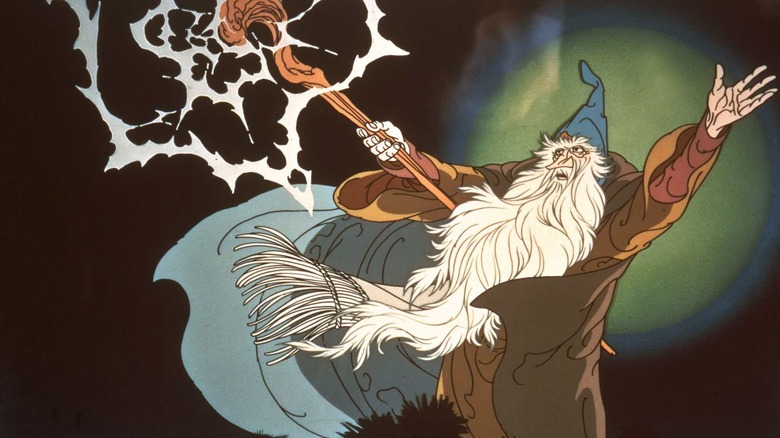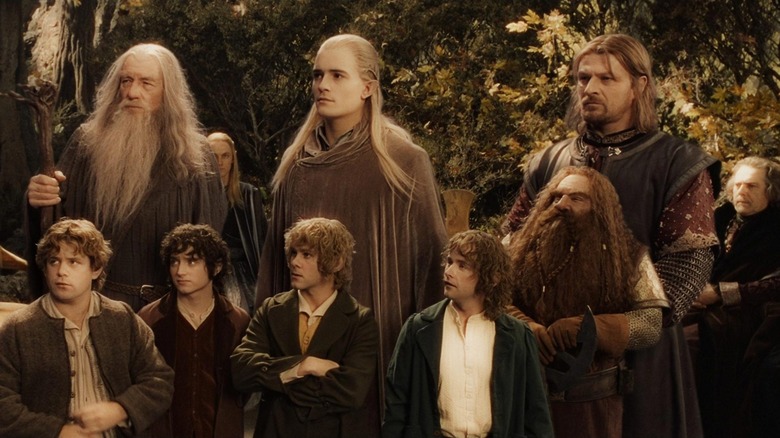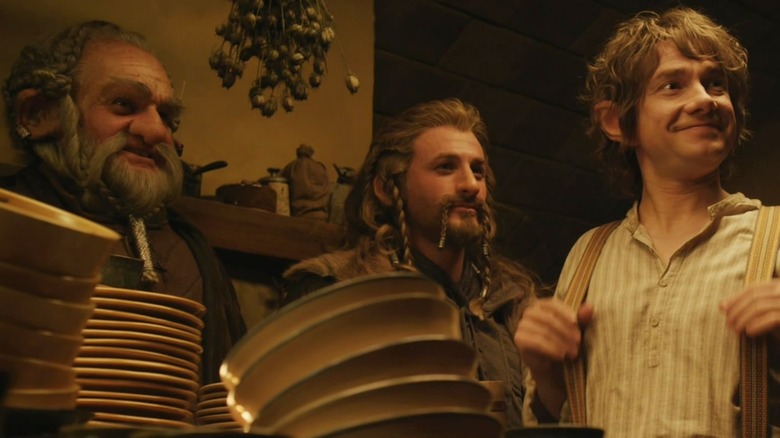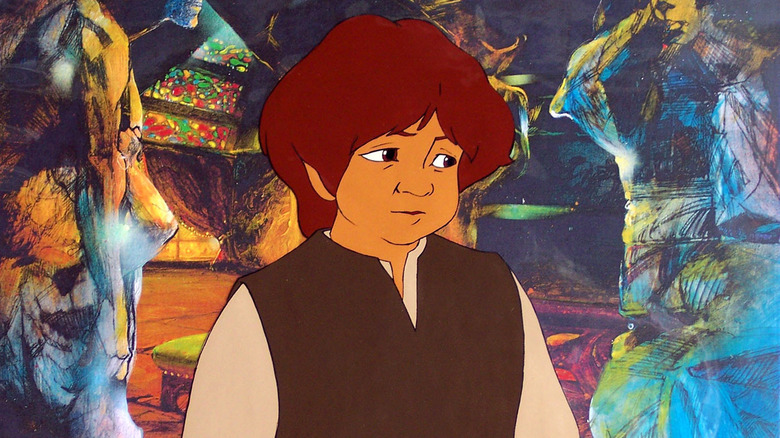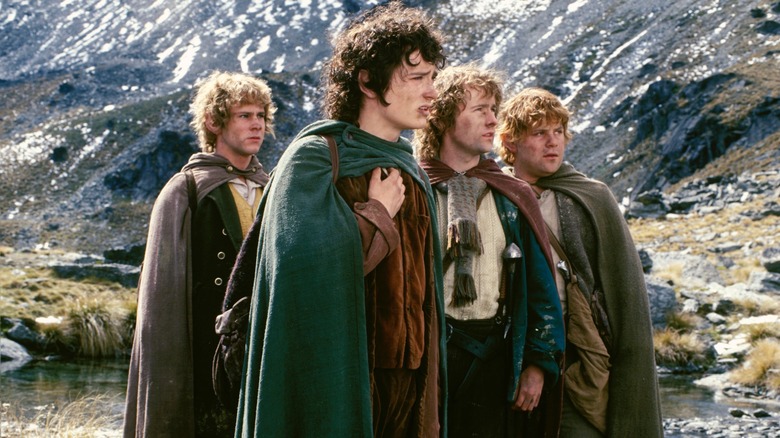The Correct Order To Watch The Lord Of The Rings Movies
At last count, there have been nine studio-sanctioned feature films to have been adapted from J.R.R. Tolkien's Middle-earth fantasy novels.
"The Hobbit," the first book in the series, was published in 1937, while a follow-up trilogy called "Lord of the Rings" was published in 1954 and 1955. Tolkien was both a linguist and a pacifist, so the books tended to lean toward elaborately constructed fantasy languages as well as antiwar themes. The mythology of Middle-earth was so vast and complex, Tolkien also wrote a book called "The Silmarillion" in which deep-cut details from within the "Rings" universe were laid out in excruciating, mythological detail.
For many years, multiple filmmakers and producers attempted to adapt the first book, "The Hobbit" to film. According to Brian J. Robb's and Paul Simpson's 2013 book "Middle-earth Envisioned: The Hobbit and The Lord of the Rings: On Screen, On Stage, and Beyond," Walt Disney had considered adapting "The Hobbit" into an animated segment as part of the 1940 film "Fantasia." Disney revisited the idea in the 1950s, but the project would have been too expensive. Also in the 1950s, Al Brodax, the producer of "Yellow Submarine" also toyed with the idea, as did horror maestro Forrest J Ackerman. It wouldn't be until 1967 that "The Hobbit" would hit the big screen in the form of an 11-minute animated short directed by Glen Deitch of Terrytoons fame.
Since then, there have been nine films, all set on a confusing chronological path across two separate continuities. One of those films, made by New Zealand gorehound Peter Jackson, won the Academy Award for Best Picture in 2003. Jackson's six "Rings" films are among the most popular in the history of fantasy cinema.
Their chronological release order is below.
The release order
If one wants to be thorough and see the "Lord of the Rings" movies in their actual release order, here is a straightforward list for the sake of clarity:
- "The Hobbit" (1967)
- "The Hobbit" (1977)
- "Lord of the Rings" (1978)
- "The Return of the King" (1980)
- "Lord of the Rings: The Fellowship of the Ring" (2001)
- "Lord of the Rings: The Two Towers" (2002)
- "Lord of the Rings: The Return of the King" (2003)
- "The Hobbit: An Unexpected Journey" (2012)
- "The Hobbit: The Desolation of Smaug" (2013)
- "The Hobbit: The Battle of the Five Armies" (2014)
- "The Lord of the Rings: The Rings of Power" (2022) (TV series)
Note that only the films from 2001 onward belong in the same continuity. The animated films, while following a common story thread, aren't necessarily sequels to one another. The 1977 "The Hobbit" and the 1980 "Return of the King," for instance, were made by a different creative team than the one that made "Lord of the Rings." There were even stories that the producer of the 1978 film wanted production on the 1980 film stopped so as to not interfere with a planned sequel. Once the live-action films debuted, storytelling consistency finally became the norm. Many "Rings" fans are likely more familiar with Peter Jackson's movies than the animated films that preceded them. The "Rings of Power" TV series, meanwhile, was not made by Jackson, but takes place in the same universe and shares a similar aesthetic.
However, if one wants a list that has been optimized for maximum clarity and time efficiency, perhaps chronological order is not ideal. See below.
The correct order
In order to absorb the full scope of Tolkien's story, and really understand the story as you go, it might be best to start with all the "Hobbit" adaptations first before delving into the "Rings" epics. Story chronology should, in this case, take precedence over production order. As such, here is the correct order:
- "The Hobbit" (1967)
- "The Hobbit" (1977)
- "The Hobbit: An Unexpected Journey" (2012)
- "The Hobbit: The Desolation of Smaug" (2013)
- The Hobbit: The Battle of the Five Armies" (2014)
- "Lord of the Rings" (1978)
- "Lord of the Rings: The Fellowship of the Ring" (2001)
- "Lord of the Rings: The Two Towers" (2002)
- "The Return of the King" (1980)
- "Lord of the Rings: The Return of the King" (2003)
Starting with the animated "The Hobbit" movies will allow viewers to understand the quaintness and simplicity of Tolkien's fantastical adventure story.
Bilbo Baggins is a simple soul who only wants creature comforts and good food. He doesn't care about adventure or heroism. At the end of the original novel, after Bilbo Baggins has faced trolls, goblins, spiders, and a giant dragon, he is roped by the honor-obsessed dwarf Thorin into a massive battle that involves five armies essentially fighting over a vast fortune of gold. Bilbo is thwacked with a rock and spends the battle unconscious. Bilbo, a pacifist who has no lust for wealth, doesn't care about the fate of the treasure. It's important that he doesn't fight.
Jackson, in making a 144-minute movie detailing the battle itself, kind of missed the point. You can feel free to skip "Battle."
The Expected Journey
Indeed, Jackson's disappointing "Hobbit" prequel films could be laid parallel with George Lucas' disappointing "Star Wars" prequel films (1999 – 2005). Both Jackson and Lucas made a popular three-film cycle of effects-heavy fantasy movies that became celebrated and took over large facets of pop culture. When both filmmakers returned to their original works more than a decade later, they only became awkward, focusing on effects and callbacks rather than effective storytelling. Lucas incorporated CGI and digital projection to a degree never before seen. Jackson, meanwhile, experimented with 3-D and high frame rates. Jackson's "Hobbit" movies are technical exercises more than anything. This is why Arthur Rankin's and Jules Bass' "The Hobbit" will need to precede everything. It will give you the most solid ground to stand on moving forward.
After the "Hobbit" story is over, one can begin the rocky and prolonged journey into "Lord of the Rings." Like the Rankin/Bass "Hobbit," one will get a moving and clear story from Ralph Bakshi's 1978 "Lord of the Rings," and the type of storytelling clarity vital to understanding the story at large. Best to watch that first.
You're now finally ready for Jackson's first "Lord of the Rings" movie, which takes place after "The Hobbit" and features an older version of Bilbo Baggins and an alternate version of Gandalf the wizard. The events of "The Hobbit" will give you a handy primer to the worlds of Elves, dwarves, and humans before the dizzyingly complex Jackson films swirl past you. The first Jackson movie begins with a prolonged intro set in Bilbo's hobbity hometown, making it a good transition from light adventure into hefty war pictures about the persistence of combat-based evil.
Which versions?
Jackson's films, famously, all have alternate cuts. Many fans prefer Jackson's extended cuts (overall, 686 minutes) over the shorter theatrical cuts (558 minutes). Controversially, I will tell you to only watch the extended cut of "The Two Towers" and the theatrical cuts of "The Fellowship of the Ring" and "The Return of the King." The extended version of "Fellowship" is, in my experience, horrendously paced, and offers no extra scenes that add to the story or enrich the setting or tone. The longer version of "The Two Towers," according to one of my more passionate "Lord of the Rings"-knowledgeable friends, is the only extended cut that offers a better sense of time and pacing, as well as a vital backstory for Boromir (Sean Bean).
The theatrical cut of "The Return of the King" excluded a scene detailing the grisly fate of Saruman, the evil wizard played by Christopher Lee. That might be the most significant cut, although the actual scene wherein Saruman dies is awkward and weirdly comedic. It's not so heavily needed that it cannot be skipped.
Overall, Jackson was a very indulgent filmmaker who liked to film and film and film, and who didn't get the knack for solid editing as a result. It will be better to have a trimmer, clearer version of "Lord of the Rings" as opposed to a massive litany of events.
As for "The Rings of Power" available on Prime Video (with a second season due in 2024), that series is set millennia prior to "The Hobbit," and is about the initial forging of the titular rings and the origin of the Dark Lord Sauron. /Film has determined that "The Rings of Power" is wholly optional.
